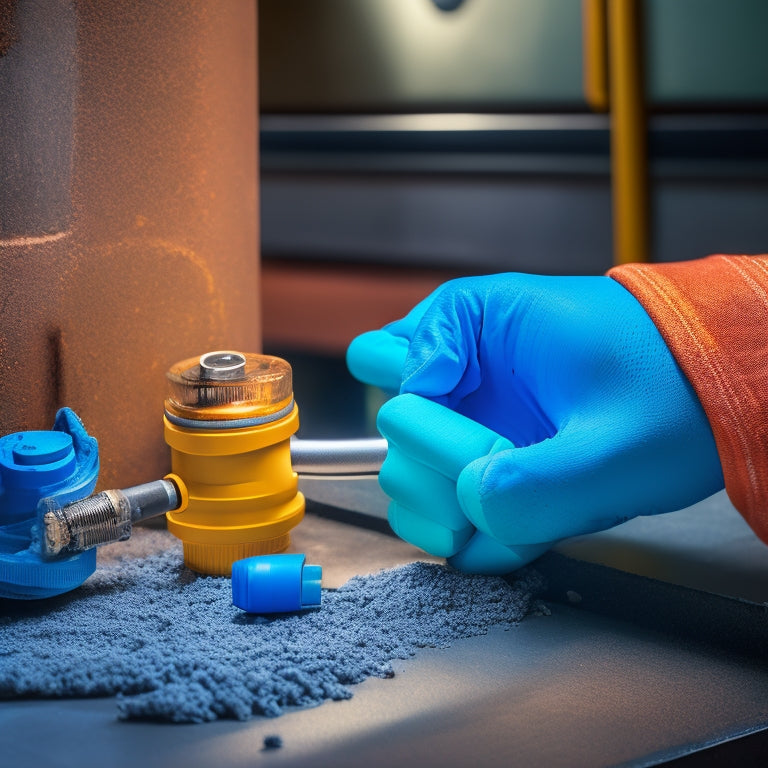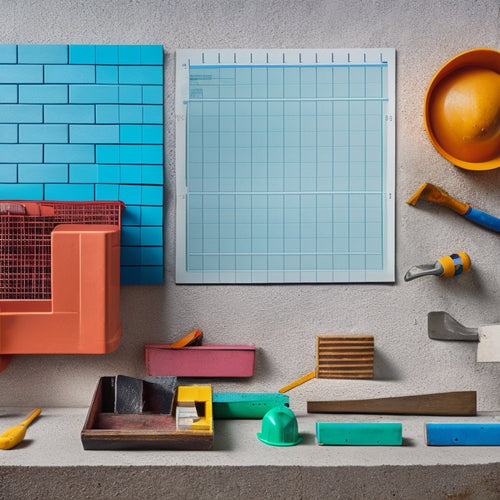
3 Best Concrete Crack Injection Repair Tools
Share
When it comes to repairing concrete cracks, you need the right tools to guarantee a successful injection process. You'll want to invest in a top-rated injection gun that maintains consistent pressure between 1,000 to 3,000 psi, an epoxy resin kit with low-to-medium viscosity and high tensile strength, and a high-pressure pumping system that can generate up to 1,500 psi. These tools will help you achieve a thorough crack fill, minimize downtime, and enhance productivity. By choosing the right tools, you'll be well on your way to a successful repair - and exploring the details of each will reveal even more benefits.
Key Takeaways
• Essential injection guns maintain high pressure for thorough crack fill and have adjustable settings for various techniques.
• Best epoxy resin kits have low viscosity, longer pot life, fast cure time, and high tensile strength for effective repair.
• High-pressure pumping systems generate up to 1,500 psi, have adjustable controls, and a gauge for accuracy and productivity.
• Regular maintenance of injection guns is crucial, including cleaning, lubrication, and proper storage for optimal performance.
• Ergonomic design and weight of injection guns influence comfort and fatigue during use, enhancing overall efficiency.
Top Rated Injection Guns
When it comes to concrete crack injection repair, you need an injection gun that can deliver a consistent, high-pressure flow of epoxy or polyurethane resin to effectively fill cracks and restore structural integrity.
A top-rated injection gun is vital for successful concrete crack injection repair. You'll want a gun that can maintain a consistent pressure of 1,000 to 3,000 psi, guaranteeing a thorough fill of the crack. Look for guns with adjustable pressure settings to accommodate various injection techniques.
Regular maintenance is important to extend the life of your injection gun. Follow maintenance tips such as cleaning the gun after each use, lubricating moving parts, and storing it in a dry place. This will make certain your gun continues to perform at its best.
Additionally, consider the ergonomic design and weight of the gun, as this will impact your comfort and fatigue during extended use.
Best Epoxy Resin Kits
You'll need a high-quality epoxy resin kit specifically designed for concrete crack injection repair to achieve a strong, durable bond that restores structural integrity and prevents further damage.
When selecting an epoxy resin kit, consider the following key factors:
-
Viscosity: Look for a kit with a low-to-medium viscosity epoxy, which will flow easily into narrow cracks and provide a strong bond.
-
Pot life: Choose a kit with a longer pot life (the time between mixing and curing) to allow for sufficient working time and ease of application.
-
Cure time: Opt for a kit with a fast cure time to minimize downtime and enable quick return to service.
A good epoxy resin kit should also exhibit excellent resin properties, such as high tensile strength, low shrinkage, and resistance to chemicals and water.
Additionally, consider epoxy applications beyond crack repair, such as bonding materials or filling voids.
High-Pressure Pumping Systems
High-pressure pumping systems, capable of generating pressures up to 1,500 psi, are essential for effectively injecting epoxy resin into tightly closed cracks and guaranteeing a strong, long-lasting bond.
You'll need a reliable high-pressure pumping system to force the epoxy resin into the crack, especially when dealing with narrow or deeply embedded cracks. When selecting a high-pressure pumping system, consider the maximum pressure required for your specific repair techniques and application methods.
Look for systems with adjustable pressure controls, allowing you to fine-tune the pressure to suit the crack's width and depth. A high-pressure pumping system with a gauge will help you monitor the pressure and flow rate, guaranteeing accurate and controlled epoxy injection.
Additionally, consider the pump's flow rate, as a higher flow rate can reduce the injection time and increase productivity. By investing in a high-quality high-pressure pumping system, you'll be able to achieve professional-grade results and guarantee a successful concrete crack injection repair.
Frequently Asked Questions
Can I Use a Drill to Mix Epoxy Resin and Hardener?
When you're mixing epoxy resin and hardener, you're tempted to use a drill, but proceed with caution.
While a drill can be effective, it's vital to avoid introducing air bubbles and excessive heat.
Opt for a low drill speed, around 200-300 RPM, to prevent this. Instead, focus on gentle, sweeping motions, and avoid whipping or blending actions.
This epoxy mixing technique will guarantee a smooth, consistent blend, fundamental for a strong bond.
How Long Does It Take for Epoxy to Fully Cure?
Think of epoxy curing like baking a cake: you mix the ingredients, pour it into a mold, and let it cook.
But instead of 30 minutes, epoxy curing time varies depending on the type and environmental conditions. Typically, it takes 24 hours for epoxy to fully cure at room temperature, but some fast-cure epoxies can harden in as little as 5 minutes.
You'll know it's fully cured when it's hard, dry, and no longer tacky to the touch.
Are There Any Safety Precautions When Working With Injection Equipment?
When working with injection equipment, you'll want to take necessary safety precautions to avoid accidents.
First, always wear personal protective gear like gloves, goggles, and a mask to prevent skin contact and inhalation of epoxy fumes.
Next, make certain equipment maintenance is up to par by regularly inspecting and cleaning nozzles, hoses, and pumps to prevent clogs and malfunctions.
Can I Inject Epoxy Into Cracks Underwater or in High-Moisture Areas?
When dealing with underwater or high-moisture areas, you'll want to guarantee the epoxy you're using is compatible with those conditions. Not all epoxies are created equal, and some may not perform well in wet environments.
Make sure to choose an epoxy specifically designed for underwater or high-moisture applications.
Additionally, consider applying moisture barriers to protect the epoxy from further water exposure. This will help guarantee a successful injection and long-lasting repair.
Do I Need to Test the Concrete Before Performing Crack Injection Repairs?
As you ponder the fate of your concrete structure, remember the ancient Greek proverb: 'Know thyself.'
Similarly, before injecting epoxy, you must know your concrete's weaknesses. Testing the concrete is essential to guarantee a successful repair.
Conduct a thorough concrete integrity assessment, including moisture testing, to determine the cause and extent of the cracks.
This due diligence will help you choose the right repair strategy and avoid costly rework.
Conclusion
As you finalize your concrete crack injection repair, it's likely you've realized that the right tools make all the difference.
Coincidentally, the top-rated injection guns, best epoxy resin kits, and high-pressure pumping systems you've chosen won't only guarantee a successful repair but also save you time and money in the long run.
With these tools, you'll be able to tackle even the most complex cracks with confidence, and your finished product will be a demonstration of your expertise.
Related Posts
-

Essential Tools for Concrete Wall Covering Projects
When tackling a concrete wall covering project, you'll need a range of essential tools and equipment. For cleaning an...
-

Reinforcement Tools Checklist for Concrete Block Walls
You'll need a range of reinforcement materials, including horizontal and vertical rebar, fiber mesh, and anchor bolts...
-

What Tools Are Needed for Concrete Wall Foundations
You'll need a thorough array of tools and equipment to construct a concrete wall foundation that meets structural int...


